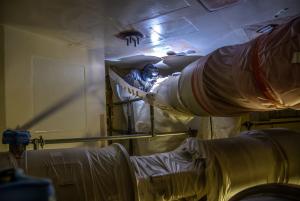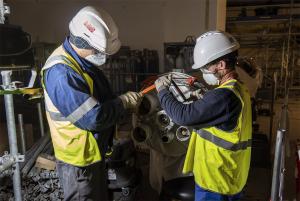Cryolines
Another day, another spool
18 May 2020
Having wedged his body and equipment into the cramped space between the ceiling and the massive pipe, a worker is busy welding two cryolines spools. A few metres below, others are adjusting the length of the inner pipes of the "multi-process" cryolines with a hacksaw. Throughout the galleries in the basement of the Tokamak Building, activity is intense. Nine months after installation work began, approximately two-thirds of the cryoline spools are now in place in the lowest basement level (B2) of the Tokamak Building.
Welding the pipes inside the multi-process cryolines is a challenging operation, sometimes performed in an extremely cramped environment.
The cryolines transport the helium needed to cool different elements of the ITER Tokamak at different temperatures. From the cryoplant, where the fluids are processed, the network travels approximately 300 metres over a bridge to the Tokamak Building.
The better part of the network ends up in the basement of the building at level B2, where it ramifies and branches to the coil termination boxes of some 30 magnet feeders.
A cryoline section, measuring 2 to 10 metres in length and 40 to 100 centimetres in diameter, is more than just a pipe. It is a sophisticated component that accommodates up to seven different process pipes, each carefully insulated and devoted to a specific fluid, flow, direction or function. There are approximately 500 such sections, or spools, to be installed inside the Tokamak Building.
Prior to welding, process pipes that transport the cooling fluid need to be cut and surfaced for optimal adjustment.
One of the challenges of the installation work is the precise positioning of each spool within a tolerance range of 5 millimetres; another is the quality of the welds connecting the sections—including both individual inner pipes and the external jacket that accommodates them. A vacuum vessel in its own right, the six-kilometre long cryoline network must be perfectly leak and vacuum tight.
Once all the spools are all in place at the B2 level, the network of cryolines will be extended in two directions: laterally towards the magnet feeders in an area called the "mezzanine," and upwards through large shafts to the L3 level of the building to meet the massive pipes and distribution boxes that are connected to the cryoplant.
The ITER construction teams expect installation to be completed this autumn.



